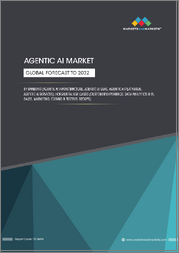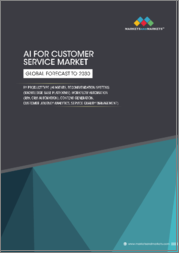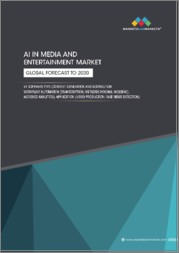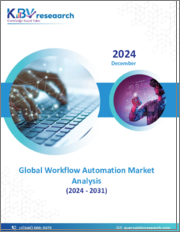
|
시장보고서
상품코드
1576502
세계의 워크플로우 자동화 시장 : 제품, 유형, 구축 방식, 조직 규모, 용도, 분야, 지역별 - 예측(-2030년)Workflow Automation Market by Offering, Type, Deployment, Organization, Application, Sector, and Geography - Global Forecast to 2030 |
||||||
본 조사 보고서는 주요 5개 지역의 워크플로우 자동화 시장을 상세하게 분석하여 현재 시장 동향, 시장 규모, 시장 점유율, 최근 연구 동향, 2031년까지의 예측 등에 중점을 두고 분석하여 전해드립니다.
워크플로우 자동화 시장은 2024-2031년간 연평균 22.2%의 성장률로 2031년까지 961억 달러에 달할 것으로 예측됩니다. 이 시장의 성장은 실시간 자동화 솔루션에 대한 수요 증가, 다양한 산업에서 비즈니스 프로세스 자동화(BPA) 도입 증가, 조직 내 C&C 강화에 대한 요구 증가에 힘입어 성장세를 보이고 있습니다. 또한, 자동화 프로세스에 클라우드 및 IoT 기술의 적용 증가, RPA(Robotic Process Automation)의 채택 증가는 시장 성장 기회를 창출할 것으로 예상됩니다.
그러나 데이터 프라이버시 및 보안에 대한 우려로 인해 시장 성장에 제동이 걸리고 있습니다. 또한, 레거시 시스템의 통합 및 호환성 문제는 이 시장에서 사업을 운영하는 기업들에게 큰 도전이 되고 있습니다. 또한, AaaS의 출현과 인공지능 및 챗봇의 활용은 워크플로우 자동화 시장의 두드러진 추세입니다.
목차
제1장 서론
제2장 조사 방법
제3장 주요 요약
- 시장 개요
- 시장 분석 : 제공 내용별
- 시장 분석 : 유형별
- 시장 분석 : 전개 형태별
- 시장 분석 : 조직 규모별
- 시장 분석 : 용도별
- 시장 분석 : 분야별
- 시장 분석 : 지역별
- 경쟁 분석
제4장 시장 인사이트
- 개요
- 시장 성장에 영향을 미치는 요인
- 성장 촉진요인
- 성장 억제요인
- 사업 기회
- 과제
- 동향
- 사례 연구
- Porter의 Five Forces 분석
제5장 워크플로우 자동화 세계 시장 : 제공 내용별 평가
- 개요
- 소프트웨어
- 서비스
제6장 워크플로우 자동화 세계 시장 : 유형별 평가
- 개요
- BPA(Business Process Automation)
- RPA(Robotic Process Automation)
제7장 워크플로우 자동화 세계 시장 : 전개 방식별 평가
- 개요
- 온프레미스
- 클라우드 기반
제8장 워크플로우 자동화 세계 시장 : 조직 규모별 평가
- 개요
- 중소기업
- 대기업
제9장 워크플로우 자동화 세계 시장 : 용도별 평가
- 개요
- 인사
- 재무
- 조달
- IT 서비스 리퀘스트
- 영업 부문
- 마케팅
- 기타 용도
제10장 워크플로우 자동화 세계 시장 : 분야별 평가
- 개요
- IT 및 통신
- 자동차
- 운송 및 물류
- 헬스케어
- 에너지 및 유틸리티
- 제조업
- 소매
- 은행/금융서비스/보험(BFSI)
- 정부 및 방위
- 기타 부문
제11장 워크플로우 자동화 시장 평가 : 지역별
- 개요
- 북미
- 미국
- 캐나다
- 유럽
- 독일
- 영국
- 프랑스
- 이탈리아
- 스페인
- 기타 유럽
- 아시아태평양
- 중국
- 일본
- 인도
- 한국
- 기타 아시아태평양
- 라틴아메리카
- 중동 및 아프리카
제12장 워크플로우 자동화 시장 평가 : 경쟁 분석
- 개요
- 주요 성장 전략
- 경쟁 벤치마킹
- 경쟁 대시보드
- 업계 리더
- 시장 차별화 요인
- 전위적 기업
- 신규 기업
- 2022년 주요 기업별 시장 점유율 분석(%)
제13장 기업 개요(기업 개요, 재무 개요, 제품 포트폴리오, 최근 동향)
- International Business Machines Corporation(U.S.)
- Software AG(Germany)
- Oracle Corporation(U.S.)
- Pegasystems Inc.(U.S.)
- Appian Corporation(U.S.)
- Bizagi Group Limited(U.S.)
- Newgen Software Technologies Limited(India)
- SAP SE(Germany)
- Formstack, LLC.(U.S.)
- Microsoft Corporation(U.S.)
- Nintex Global Ltd.(U.S.)
- ServiceNow, Inc.(U.S.)
- IPsoft Inc.(Amelia LLC)(U.S.)
- Xerox Holdings Corporation(U.S.)
- Open Text Corporation(Canada)
- monday.com Ltd.(Israel)
- SysAid Technologies Ltd.(Israel)
- Jotform Inc.(U.S.)
- Kissflow Inc.(U.S.)
- Next Matter GmbH(Germany)
- DocuWare GmbH(Germany)
- Camunda Services GmbH(Germany)
- Adobe(U.S.)
- HeightHQ, Inc.(U.S.)
- ClickUp(U.S.)
- Integrify, Inc.(U.S.)
- Flokzu(Uruguay)
- Wrike, Inc.(U.S.)
- Zapier, Inc.(U.S.)
- Really Simple Systems Ltd.(U.K.)
(주 : 주요 5개사의 SWOT 분석을 제공합니다.)
제14장 부록
LSH 24.11.12Workflow Automation Market by Offering, Type (Business Process Automation, Robotic Process Automation), Deployment, Organization, Application (Finance, Procurement), Sector (BFSI, Healthcare, Transportation & Logistics), and Geography-Forecast to 2030
The research report titled 'Workflow Automation Market by Offering, Type (Business Process Automation, Robotic Process Automation), Deployment, Organization, Application (Finance, Procurement), Sector (BFSI, Healthcare, Transportation & Logistics), and Geography-Forecast to 2030', provides in-depth analysis of the workflow automation market across five major geographies and emphasizes on the current market trends, market sizes, market shares, recent developments, and forecasts till 2031.
The workflow automation market is projected to reach $96.1 billion by 2031, at a CAGR of 22.2% from 2024 to 2031. The growth of this market is driven by the rising demand for real-time automation solutions, the increasing adoption of business process automation across various industries, and the growing need for enhanced communication and collaboration within organizations. Additionally, the increasing applications of cloud and IoT technologies in automation processes and the rising adoption of robotic process automation (RPA) are anticipated to create significant market growth opportunities.
However, concerns related to data privacy and security restrain the market's growth. Additionally, issues related to the integration and compatibility of legacy systems pose significant challenges for the players operating in this market. Furthermore, the emergence of automation-as-a-service (AaaS) and the utilization of artificial intelligence and chatbots are prominent trends in the workflow automation market.
The global workflow automation market is segmented by offering, type, deployment mode, organization size, application, and sector. The study also evaluates industry competitors and analyzes the market at the regional and country levels.
Based on offering, the global workflow automation market is broadly segmented into software and services. In 2024, the software segment is expected to account for a larger share of over 58.0% of the global workflow automation market. The large market share of this segment is attributed to the increasing demand for IT automation software, the rising need for more efficient and streamlined business processes, the increasing focus on solution-centric automation capabilities, and the growing demand for quick data processing and decision-making.
However, the services segment is projected to register a higher CAGR during the forecast period. This growth is driven by the growing intricacies and customizations in workflow automation projects, rising demand for maintenance and training services, and an increased need for professional services among end users.
Based on type, the global workflow automation market is broadly segmented into business process automation and robotic process automation. In 2024, the business process automation segment is expected to account for a larger share of over 72.0% of the global workflow automation market. The large market share of this segment is attributed to factors such as the rising need to automate repetitive tasks, the need to enhance accountability and transparency and ensure precise data recording, and the surge in digital transformation efforts among enterprises.
However, the robotic process automation segment is projected to register a higher CAGR during the forecast period. This growth can be attributed to the increasing need to minimize human errors, enhance work efficiency, reduce overhead expenses, improve the accuracy and reliability of business processes, and reduce operational costs, the increasing adoption of advanced technologies, including Artificial Intelligence (AI), in business processes, and the rising demand for robotic process automation in the BFSI, healthcare, and transportation & logistics sectors to meet their operational demands.
Based on deployment mode, the global workflow automation market is broadly segmented into on-premise deployments and cloud-based deployments. In 2024, the on-premise deployments segment is expected to account for a larger share of over 52.0% of the global workflow automation market. The large market share of this segment can be attributed to factors such as the growing demand for systems that can automate and execute repetitive tasks and the rising need for lower latency and improved data sovereignty.
However, the cloud-based deployments segment is projected to register the highest CAGR during the forecast period. This growth is driven by the increasing utilization of cloud-based workflow automation, the enhanced flexibility provided by cloud-based deployments, the growing adoption of cloud-based solutions by small and medium-sized enterprises, and the rising demand for cost-effective subscription models and automated threat detection solutions.
Based on organization size, the global workflow automation market is broadly segmented into SMEs and large enterprises. In 2024, the large enterprises segment is expected to account for the larger share of over 60.0% of the global workflow automation market. The large market share of this segment can be attributed to the growing demand for consistency across various operations within large enterprises, the increasing focus on digital transformation initiatives, and the rising adoption of robotic process automation to streamline repetitive tasks
However, the SMEs segment is projected to register the highest CAGR during the forecast period. The rapid growth in this segment is attributed to the increasing significance of digital solutions, including CRM and ERP platforms, for enhancing productivity and the growing awareness among SMEs regarding the benefits of automating business processes.
Based on application, the global workflow automation market is broadly segmented into human resources, finance, procurement, IT service requests, sales, marketing, and other applications. In 2024, the finance segment is expected to account for the largest share of over 29.0% of the global workflow automation market. The large market share of this segment can be attributed to the rising need to improve financial services and document management, an increasing focus on enhancing customer experiences, the growing implementation of RPA to reduce labor costs and improve operational efficiency, and the widespread use of digital banking solutions for real-time transaction processing and data accuracy in financial operations. Moreover, the finance segment is projected to register the highest CAGR during the forecast period.
Based on sector, the global workflow automation market is broadly segmented into IT & telecommunications, automotive, transportation & logistics, healthcare, energy & utilities, manufacturing, retail, BFSI, government & defense, and other sectors. In 2024, the manufacturing segment is expected to account for the largest share of over 24.0% of the global workflow automation market. The large market share of this segment is attributed to the rising demand for computer-integrated manufacturing automation, a growing emphasis on boosting manufacturing production efficiency and supply chain optimization through automation, the rising adoption of Industry 4.0 and smart manufacturing technologies, and the increasing deployment of robotic process automation (RPA) for executing a wide range of manual tasks such as stacking, painting, welding, polishing, labeling, and assembly.
However, the BFSI segment is projected to register the highest CAGR during the forecast period due to the increasing need for seamless communication with customers to enhance workflow agility and customer experience, the rising demand for fraud detection solutions in the BFSI sector, the implementation of RPA to improve efficiency and work speed, the increasing adoption of online financial services, and the growing need to automate numerous time-consuming, repetitive processes like account opening, the KYC process, customer services, and more.
Based on geography, the global workflow automation market is segmented into Asia-Pacific, Europe, North America, the Middle East & Africa, and Latin America. In 2024, Asia-Pacific is expected to account for the largest share of over 34.0% of the global workflow automation market, followed by Europe, North America, Latin America, and the Middle East & Africa. Asia-Pacific's significant market share can be attributed to various factors, such as the increasing emphasis on Industry 4.0 initiatives and digital transformation, the widespread adoption of robotic process automation and other advanced technologies, such as AI, robotics, IoT, and cloud computing, across various sectors, the rising number of government initiatives aimed at digitization, and the rising demand for cost-effective and efficient automation solutions to manage repetitive tasks. Moreover, Asia-Pacific is also projected to register the highest CAGR during the forecast period.
Key Players:
The key players operating in the workflow automation market include International Business Machines Corporation (U.S.), Software AG (Germany), Oracle Corporation (U.S.), Pegasystems Inc. (U.S.), Appian Corporation (U.S.), Bizagi Group Limited (U.S.), Newgen Software Technologies Limited (India), Zapier, Inc. (U.S.), Formstack, LLC. (U.S.), Microsoft Corporation (U.S.), Nintex Global Ltd. (U.S.), ServiceNow, Inc. (U.S.), IPsoft Inc. (Amelia LLC) (U.S.), Xerox Holdings Corporation (U.S.), Open Text Corporation (Canada), monday.com Ltd. (Israel), SysAid Technologies Ltd. (Israel), Jotform Inc. (U.S.), Kissflow Inc. (U.S.), Next Matter GmbH (Germany), DocuWare GmbH (Germany), Camunda Services GmbH (Germany), Adobe (U.S.), HeightHQ, Inc. (U.S.), ClickUp (U.S.), Integrify, Inc. (U.S.), Flokzu (Uruguay), Wrike, Inc. (U.S.), SAP SE (Germany), and Really Simple Systems Ltd. (U.K.).
Key questions answered in the report:
- Which are the high-growth segments in the workflow automation market based on offering, type, deployment mode, organization size, application, sector, and geography?
- What is the historical market size for workflow automation across the globe?
- What are the market forecasts and estimates for the period 2024-2031?
- What are the major drivers, restraints, opportunities, and challenges in the workflow automation market?
- Who are the major players, and what shares do they hold in the workflow automation market?
- What is the competitive landscape like in the workflow automation market?
- What are the recent developments in the workflow automation market?
- What are the different strategies adopted by the major players in the workflow automation market?
- What are the key geographic trends, and which are the high-growth countries in the workflow automation market?
- Who are the local emerging players in the workflow automation market, and how do they compete with the other players?
Scope of the report:
Workflow Automation Market Assessment-by Offering
- Software
- Services
Workflow Automation Market Assessment-by Type
- Business Process Automation
- Robotic Process Automation
Workflow Automation Market Assessment-by Deployment Mode
- On-premise Deployments
- Cloud-based Deployments
Workflow Automation Market Assessment-by Organization Size
- SMEs
- Large Enterprises
Workflow Automation Market Assessment-by Application
- Human Resources
- Finance
- Procurement
- IT Service Requests
- Sales
- Marketing
- Other Applications
Workflow Automation Market Assessment-by Sector
- IT & Telecommunications
- Automotive
- Transportation & Logistics
- Healthcare
- Energy & Utilities
- Manufacturing
- Retail
- BFSI
- Government & Defense
- Other Sectors
Workflow Automation Market Assessment-by Geography
- North America
- U.S.
- Canada
- Europe
- Germany
- U.K.
- France
- Italy
- Spain
- Rest of Europe
- Asia-Pacific
- China
- Japan
- India
- South Korea
- Rest of Asia-Pacific
- Middle East & Africa
- Latin America
TABLE OF CONTENTS
1. Introduction
- 1.1 Market Definition
- 1.2 Currency and Limitations
- 1.2.1 Currency
- 1.2.2 Limitations
2. Research Methodology
- 2.1 Research Approach
- 2.2 Process of Data Collection and Validation
- 2.2.1 Secondary Research
- 2.2.2 Primary Research/Interviews with Key Opinion Leaders of the Industry
- 2.3 Market Sizing and Forecast Approach
- 2.3.1 Market Size Estimation Approach
- 2.3.2 Growth Forecast Approach
- 2.4 Assumption for the Study
3. Executive Summary
- 3.1 Market Overview
- 3.2 Market Analysis, by Offering
- 3.3 Market Analysis, by Type
- 3.4 Market Analysis, by Deployment Mode
- 3.5 Market Analysis, by Organization Size
- 3.6 Market Analysis, by Application
- 3.7 Market Analysis, by Sector
- 3.8 Market Analysis, by Geography
- 3.9 Competitive Analysis
4. Market Insights
- 4.1 Overview
- 4.2 Factors Affecting Market Growth
- 4.2.1 Drivers
- 4.2.1.1 Rising Demand for Real-time Automation Solutions
- 4.2.1.2 Increasing Adoption of Business Process Automation Across Various Industries
- 4.2.1.3 Growing Need for Enhanced Communication and Collaboration Within Organizations
- 4.2.2 Restraints
- 4.2.2.1 Data Privacy and Security Concerns
- 4.2.3 Opportunities
- 4.2.3.1 Increasing Applications of Cloud and IoT Technologies in Automation Processes
- 4.2.3.2 Rising Adoption of Robotic Process Automation (RPA)
- 4.2.4 Challenges
- 4.2.4.1 Integration and Compatibility Issues of Legacy Systems
- 4.2.5 Trends
- 4.2.5.1 Automation-as-a-Service (AaaS)
- 4.2.5.2 Artificial Intelligence and Chatbots
- 4.2.1 Drivers
- 4.3 Case Studies
- 4.4 Porter's Five Forces Analysis
5. Global Workflow Automation Market Assessment-by Offering
- 5.1 Overview
- 5.2 Software
- 5.3 Services
6. Global Workflow Automation Market Assessment-by Type
- 6.1 Overview
- 6.2 Business Process Automation
- 6.3 Robotic Process Automation
7. Global Workflow Automation Market Assessment-by Deployment Mode
- 7.1 Overview
- 7.2 On-premise Deployments
- 7.3 Cloud-based Deployments
8. Global Workflow Automation Market Assessment-by Organization Size
- 8.1 Overview
- 8.2 SMEs
- 8.3 Large Enterprises
9. Global Workflow Automation Market Assessment-by Application
- 9.1 Overview
- 9.2 Human Resources
- 9.3 Finance
- 9.4 Procurement
- 9.5 IT Service Requests
- 9.6 Sales
- 9.7 Marketing
- 9.8 Other Applications
10. Global Workflow Automation Market Assessment-by Sector
- 10.1 Overview
- 10.2 IT & Telecommunications
- 10.3 Automotive
- 10.4 Transportation & Logistics
- 10.5 Healthcare
- 10.6 Energy & Utilities
- 10.7 Manufacturing
- 10.8 Retail
- 10.9 BFSI
- 10.10 Government & Defense
- 10.11 Other Sectors
11. Workflow Automation Market Assessment-by Geography
- 11.1 Overview
- 11.2 North America
- 11.2.1 U.S.
- 11.2.2 Canada
- 11.3 Europe
- 11.3.1 Germany
- 11.3.2 U.K.
- 11.3.3 France
- 11.3.4 Italy
- 11.3.5 Spain
- 11.3.6 Rest of Europe
- 11.4 Asia-Pacific
- 11.4.1 China
- 11.4.2 Japan
- 11.4.3 India
- 11.4.4 South Korea
- 11.4.5 Rest of Asia-Pacific
- 11.5 Latin America
- 11.6 Middle East & Africa
12. Workflow Automation Market Assessment-Competitive Analysis
- 12.1 Overview
- 12.2 Key Growth Strategies
- 12.3 Competitive Benchmarking
- 12.4 Competitive Dashboard
- 12.4.1 Industry Leaders
- 12.4.2 Market Differentiators
- 12.4.3 Vanguards
- 12.4.4 Emerging Companies
- 12.5 Market Share Analysis, By Key Player, 2022 (%)
13. Company Profiles (Company Overview, Financial Overview, Product Portfolio, and Recent Developments)
- 13.1 International Business Machines Corporation (U.S.)
- 13.2 Software AG (Germany)
- 13.3 Oracle Corporation (U.S.)
- 13.4 Pegasystems Inc. (U.S.)
- 13.5 Appian Corporation (U.S.)
- 13.6 Bizagi Group Limited (U.S.)
- 13.7 Newgen Software Technologies Limited (India)
- 13.8 SAP SE (Germany)
- 13.9 Formstack, LLC. (U.S.)
- 13.10 Microsoft Corporation (U.S.)
- 13.11 Nintex Global Ltd. (U.S.)
- 13.12 ServiceNow, Inc. (U.S.)
- 13.13 IPsoft Inc. (Amelia LLC) (U.S.)
- 13.14 Xerox Holdings Corporation (U.S.)
- 13.15 Open Text Corporation (Canada)
- 13.16 monday.com Ltd. (Israel)
- 13.17 SysAid Technologies Ltd. (Israel)
- 13.18 Jotform Inc. (U.S.)
- 13.19 Kissflow Inc. (U.S.)
- 13.20 Next Matter GmbH (Germany)
- 13.21 DocuWare GmbH (Germany)
- 13.22 Camunda Services GmbH (Germany)
- 13.23 Adobe (U.S.)
- 13.24 HeightHQ, Inc. (U.S.)
- 13.25 ClickUp (U.S.)
- 13.26 Integrify, Inc. (U.S.)
- 13.27 Flokzu (Uruguay)
- 13.28 Wrike, Inc. (U.S.)
- 13.29 Zapier, Inc. (U.S.)
- 13.30 Really Simple Systems Ltd. (U.K.)
(Note: SWOT Analysis of the Top 5 Companies will be provided)
14. Appendix
- 14.1 Available Customization
- 14.2 Related Reports



















